Integrator
PARTS AND MATERIALS
-
Four 6 volt batteries
-
Operational amplifier, model 1458
recommended (Radio Shack catalog # 276-038)
-
One 10 kΩ potentiometer, linear taper
(Radio Shack catalog # 271-1715)
-
Two capacitors, 0.1 �F each, non-polarized
(Radio Shack catalog # 272-135)
-
Two 100 kΩ resistors
-
Three 1 MΩ resistors
Just about any operational amplifier model
will work fine for this integrator experiment, but I'm
specifying the model 1458 over the 353 because the 1458 has
much higher input bias currents. Normally, high input bias
current is a bad characteristic for an op-amp to have in a
precision DC amplifier circuit (and especially an integrator
circuit!). However, I want the bias current to be high in
order that its bad effects may be exaggerated, and so that
you will learn one method of counteracting its effects.
CROSS-REFERENCES
Lessons In Electric Circuits, Volume
3, chapter 8: "Operational Amplifiers"
LEARNING OBJECTIVES
-
Method for limiting the span of a
potentiometer
-
Purpose of an integrator circuit
-
How to compensate for op-amp bias current
SCHEMATIC DIAGRAM
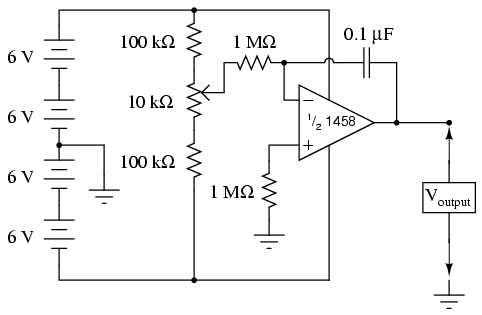
ILLUSTRATION
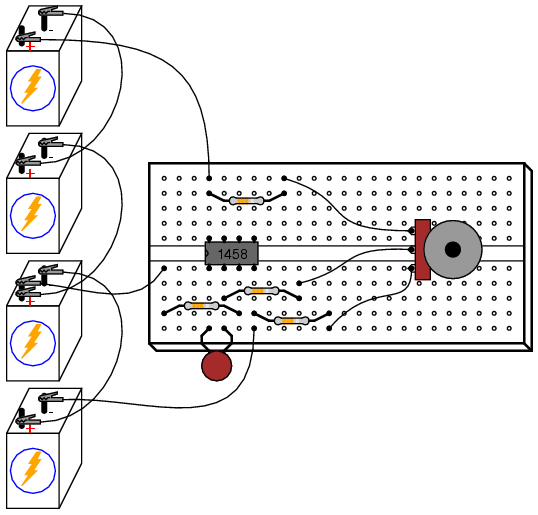
INSTRUCTIONS
As you can see from the schematic diagram,
the potentiometer is connected to the "rails" of the power
source through 100 kΩ resistors, one on each end. This is to
limit the span of the potentiometer, so that full movement
produces a fairly small range of input voltages for the
op-amp to operate on. At one extreme of the potentiometer's
motion, a voltage of about 0.5 volt (with respect the the
ground point in the middle of the series battery string)
will be produced at the potentiometer wiper. At the other
extreme of motion, a voltage of about -0.5 volt will be
produced. When the potentiometer is positioned dead-center,
the wiper voltage should measure zero volts.
Connect a voltmeter between the op-amp's
output terminal and the circuit ground point. Slowly move
the potentiometer control while monitoring the output
voltage. The output voltage should be changing at a
rate established by the potentiometer's deviation from zero
(center) position. To use calculus terms, we would say that
the output voltage represents the integral (with
respect to time) of the input voltage function. That is, the
input voltage level establishes the output voltage rate
of change over time. This is precisely the opposite of
differentiation, where the derivative of a
signal or function is its instantaneous rate of change.
If you have two voltmeters, you may readily
see this relationship between input voltage and output
voltage rate of change by measuring the wiper voltage
(between the potentiometer wiper and ground) with one meter
and the output voltage (between the op-amp output terminal
and ground) with the other. Adjusting the potentiometer to
give zero volts should result in the slowest output voltage
rate-of-change. Conversely, the more voltage input to this
circuit, the faster its output voltage will change, or
"ramp."
Try connecting the second 0.1 �F capacitor
in parallel with the first. This will double the amount of
capacitance in the op-amp's feedback loop. What affect does
this have on the circuit's integration rate for any given
potentiometer position?
Try connecting another 1 MΩ resistor in
parallel with the input resistor (the resistor connecting
the potentiometer wiper to the inverting terminal of the
op-amp). This will halve the integrator's input resistance.
What affect does this have on the circuit's integration
rate?
Integrator circuits are one of the
fundamental "building-block" functions of an analog
computer. By connecting integrator circuits with amplifiers,
summers, and potentiometers (dividers), almost any
differential equation could be modeled, and solutions
obtained by measuring voltages produced at various points in
the network of circuits. Because differential equations
describe so many physical processes, analog computers are
useful as simulators. Before the advent of modern digital
computers, engineers used analog computers to simulate such
processes as machinery vibration, rocket trajectory, and
control system response. Even though analog computers are
considered obsolete by modern standards, their constituent
components still work well as learning tools for calculus
concepts.
Move the potentiometer until the op-amp's
output voltage is as close to zero as you can get it, and
moving as slowly as you can make it. Disconnect the
integrator input from the potentiometer wiper terminal and
connect it instead to ground, like this:
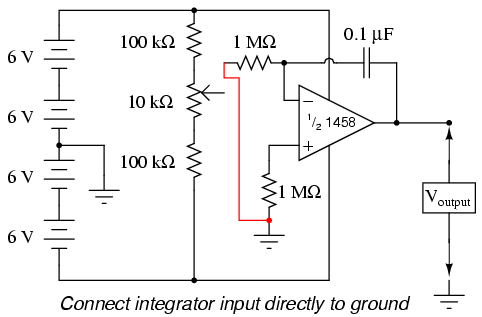
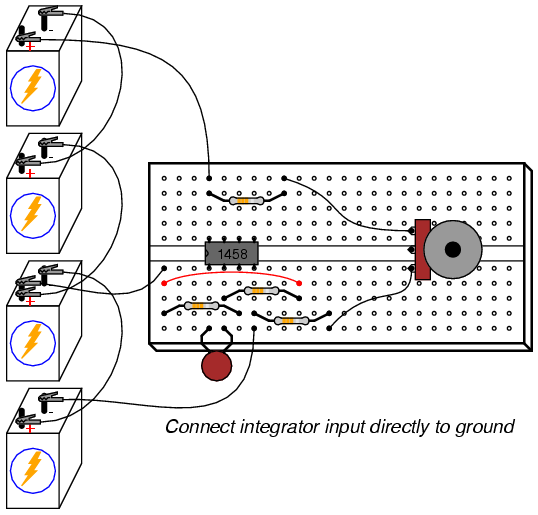
Applying exactly zero voltage to the input
of an integrator circuit should, ideally, cause the output
voltage rate-of-change to be zero. When you make this change
to the circuit, you should notice the output voltage
remaining at a constant level or changing very slowly.
With the integrator input still shorted to
ground, short past the 1 MΩ resistor connecting the op-amp's
noninverting (+) input to ground. There should be no need
for this resistor in an ideal op-amp circuit, so by shorting
past it we will see what function it provides in this very
real op-amp circuit:
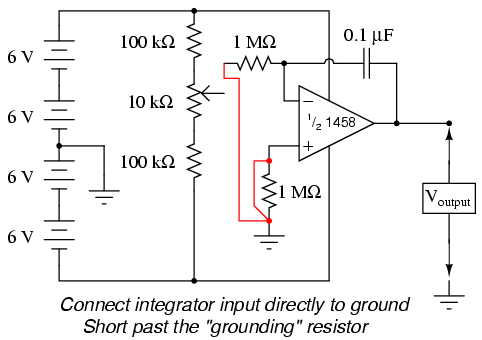
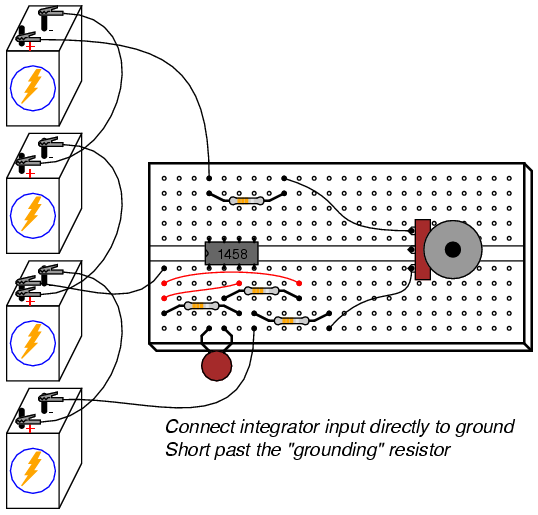
As soon as the "grounding" resistor is
shorted with a jumper wire, the op-amp's output voltage will
start to change, or drift. Ideally, this should not happen,
because the integrator circuit still has an input signal of
zero volts. However, real operational amplifiers have a very
small amount of current entering each input terminal called
the bias current. These bias currents will drop
voltage across any resistance in their path. Since the 1 MΩ
input resistor conducts some amount of bias current
regardless of input signal magnitude, it will drop voltage
across its terminals due to bias current, thus "offsetting"
the amount of signal voltage seen at the inverting terminal
of the op-amp. If the other (noninverting) input is
connected directly to ground as we have done here, this
"offset" voltage incurred by voltage drop generated by bias
current will cause the integrator circuit to slowly
"integrate" as though it were receiving a very small input
signal.
The "grounding" resistor is better known as
a compensating resistor, because it acts to
compensate for voltage errors created by bias current. Since
the bias currents through each op-amp input terminal are
approximately equal to each other, an equal amount of
resistance placed in the path of each bias current will
produce approximately the same voltage drop. Equal voltage
drops seen at the complementary inputs of an op-amp cancel
each other out, thus nulling the error otherwise induced by
bias current.
Remove the jumper wire shorting past the
compensating resistor and notice how the op-amp output
returns to a relatively stable state. It may still drift
some, most likely due to bias voltage error in the
op-amp itself, but that is another subject altogether!
COMPUTER SIMULATION
Schematic with SPICE node numbers:
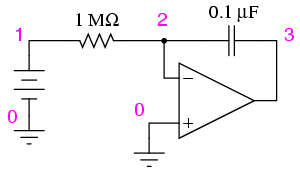
Netlist (make a text file containing the
following text, verbatim):
DC integrator
vinput 1 0 dc 0.05
r1 1 2 1meg
c1 2 3 0.1u ic=0
e1 3 0 0 2 999k
.tran 1 30 uic
.plot tran v(1,0) v(3,0)
.end
|